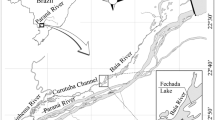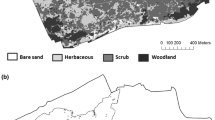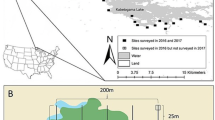Abstract
There has been a significant loss in the UK, and elsewhere in Europe, of moorland dominated by heather Calluna vulgaris. One response to this has been the initiation of moorland vegetation restoration projects. Heather moorland has distinct assemblages of invertebrates and the ability of these to colonise newly created habitat patches has not previously been experimentally tested.
We established a dispersal and colonisation experiment by transplanting C. vulgaris-dominated turfs within grassland at different distances (up to 40 m) from heather moorland vegetation. Hemiptera were cleared from these turfs by the use of an insecticide and were sampled 1 year later to investigate re-colonisation rates.
Hemiptera assemblages on transplanted turfs were most dissimilar to those of heather moor at the greatest distances of these turfs from heather moor. Colonisation rates of heathland-indicator Hemiptera declined exponentially with distance. The number of individual heathland-indicator Hemiptera was higher on turfs 5 and 10 m from heather moor than on turfs transplanted back into the heather moor, possibly due to a crowding effect.
Our findings indicate that moorland Hemiptera assemblages may be limited by dispersal ability. We recommend that moorland restoration schemes should be prioritised on ground as close as possible to existing heather moors.






Similar content being viewed by others
References
Anderson P, Yalden DW (1981) Increased sheep numbers and the loss of heather moorland in the Peak District, England. Biol Conserv 20:195–213
Anderson PA, Tallis JH, Yalden DW (1997) Restoring moorland. The moorland management project phase 3 report. Peak district moorland management project, Bakewell, Derbyshire, UK
Anon (2003) Principles of moorland management. Scotland’s Moorland Forum, Edinburgh, UK
Bardgett RD, Marsden JH, Howard DC (1995) The extent and condition of heather on moorland in the uplands of England and Wales. Biol Conserv 71:155–161
Barclay-Estrup P, Gimingham CH (1969) The description and interpretation of cyclical processes in a heath community. I. Vegetational change in relation to the Calluna cycle. J Ecol 57:737–758
Biedermann R (2004) Patch occupancy of two hemipterans sharing a common host plant. J Biogeogr 31:1179–1184
Biedermann R, Niedringhaus R (2004) Die Zikaden Deutschlands. Fründ, Westerwiesenweg, Germany
Buchanan GM, Grant MC, Sanderson RA, Pearce-Higgins JW (2006) The contribution of invertebrate taxa to moorland bird diets and the potential implications of land-use management. Ibis 148:615–628
Brown JH, Kodric-Brown A (1977) Turnover rates in insular biogeography: effect of immigration on extinction. Ecology 58:445–449
Cherrill AJ, Rushton SP (1993) The Auchenorrhyncha of an unimproved moorland in northern England. Ecol Entomol 18:95–103
Coulson JC, Butterfield JEL (1985) The invertebrate communities of peat and upland grasslands in the north of England and some conservation implications. Biol Conserv 1985:197–225
Cronin JT (2004) Host-parasitoid extinction and colonization in a fragmented prairie landscape. Oecologia 139:503–514
Debinski DM, Holt RD (2000) A survey and overview of habitat fragmentation experiments. Conserv Biol 14:342–355
Finn JA, Giller PS (2000) Patch size and colonisation patterns: an experimental analysis using north temperate coprophagous dung beetles. Ecography 23:315–327
Förare J, Solbreck C (1997) Population structure of a monophagous moth in a patchy landscape. Ecol Entomol 22:256–263
GenStat Committee (2004) GenStat Release 7.2. Lawes agricultural trust rothamsted experimental station. Herts, UK
Gimingham CH (1985) Age-related interactions between Calluna vulgaris and phytophagous insects. Oikos 44:12–16
Hartley SE, Gardner SM, Mitchell RJ (2003) Indirect effects of grazing and nutrient addition on the hemipteran community of heather moorlands. J Appl Ecol 40:793–803
Hollier JA, Maczey N, Masters GJ, Mortimer SR (2005) Grassland leafhoppers (Hemiptera: Auchenorrhyncha) as indicators of habitat condition—a comparison of between-site and between-year differences in assemblage composition. J Insect Conserv 9:299–307
Huntings Surveys (1986) Monitoring landscape change, vol 1. Main Report. Huntings Surveys, Borehamwood, UK
Le Quesne WJ, Payne KR (1981) Cicadellidae (Typhlocybinae) with a checklist of the British Auchenorrhyncha (Hemiptera, Homoptera). Handbooks for the identification of british insects, [II, 2(c)], Royal Entomological Society, London, UK, pp 1–95
Littlewood NA, Pakeman RJ, Woodin SJ (2006a) A field assessment of the success of moorland restoration in the rehabilitation of whole plant assemblages. Appl Veg Sci 9:295–306
Littlewood NA, Pakeman RJ, Woodin SJ (2006b) The response of plant and insect assemblages to the loss of Calluna vulgaris from upland vegetation. Biol Conserv 128:335–345
Littlewood NA, Dennis P, Pakeman RJ, Woodin SJ (2006c) Moorland restoration aids the reassembly of associated phytophagous insects. Biol Conserv 132:395–404
MacArthur RH, Wilson EO (1963) An equilibrium theory of insular zoogeography. Evolution 17:373–387
McFerran DM, McAdam JH, Montgomery WI (1995) The impact of burning and grazing on heathland plants and invertebrates in County Antrim. Biol Environ: Proc R Ir Acad 95B:1–17
Minitab Inc. (2003) MINITAB statistical software, release 14 for windows. State College, Pennsylvania, USA
Nickel H, Achtziger R (2005) Do they ever come back? Responses of leafhopper communities to extensification of land use. J Insect Conserv 9:319–333
Nickel H, Remane R (2002) Artenliste der Zikaden Deutschlands, mit Angabe on Nährpflanzen, Nahrungsbreite, Lebenszyklus, Areal und Gefährdung (Hemiptera, Fulgoromorpha et Cicadomorpha). Beiträge zur Zikadenkunde 5:27–64
Palmer MA, Ambrose RF, Poff NL (1997) Ecological theory and community restoration ecology. Restor Ecol 5:291–300
Scottish Natural Heritage (1994) National countryside monitoring scheme Scotland: main report of findings. Scottish Natural Heritage, Battleby, UK
Simberloff DS, Wilson EO (1969) Experimental zoogeography of islands: the colonization of empty islands. Ecology 50:278–296
Solbreck C, Sillén-Tullberg B (1990) Population dynamics of a seed feeding bug, Lygaeus equestris. 1. Habitat patch structure and spatial dynamics. Oikos 58:199–209
Southwood TRE, Leston D (1959) Land and water bugs of the British Isles. Frederick Warne & Co. Ltd, London, UK
Stace C (1991) New Flora of the British Isles. Cambridge University Press, Cambridge, UK
Stewart AJ, Wright AF (1995) A new inexpensive suction apparatus for sampling arthropods in grassland. Ecol Entomol 20:98–102
ter Braak CJF, Šmilauer P (2002) CANOCO Reference Manual and CanoDraw for Windows User’s Guide; Software for Canonical Community Ordination (Version 4.5). Microcomputer Power, Ithaca, NY, USA
Tudor GJ, Mackey EC (1995) Upland land cover change in post-war Scotland. In: Thompson DBA, Hester AJ, Usher MB (eds) Heaths and moorland: cultural landscapes. Scottish Natural Heritage, Edinburgh, UK, pp 28–42
Waloff N (1973) Dispersal by flight of leafhoppers (Auchenorrhyncha: Homoptera). J Appl Ecol 10:705–730
Zabel J, Tscharntke T (1998) Does fragmentation of Urtica habitats affect phytophagous and predatory insects differentially? Oecologia 116:419–425
Acknowledgements
For help with establishment of the experiment, analysis of materials and statistical advice we thank Olivia Breffit, David Elston, Stephen Hewitt, Louis Irving, Norbert Maczey, Jackie Potts and Jim Small. Pete Dennis and two anonymous referees provided useful comments on the manuscript. The work was funded by the Natural Environmental Research Council and the Macaulay Institute.
Author information
Authors and Affiliations
Corresponding author
Rights and permissions
About this article
Cite this article
Littlewood, N.A., Pakeman, R.J. & Woodin, S.J. Isolation of habitat patches limits colonisation by moorland Hemiptera. J Insect Conserv 13, 29–36 (2009). https://doi.org/10.1007/s10841-007-9114-5
Received:
Accepted:
Published:
Issue Date:
DOI: https://doi.org/10.1007/s10841-007-9114-5




